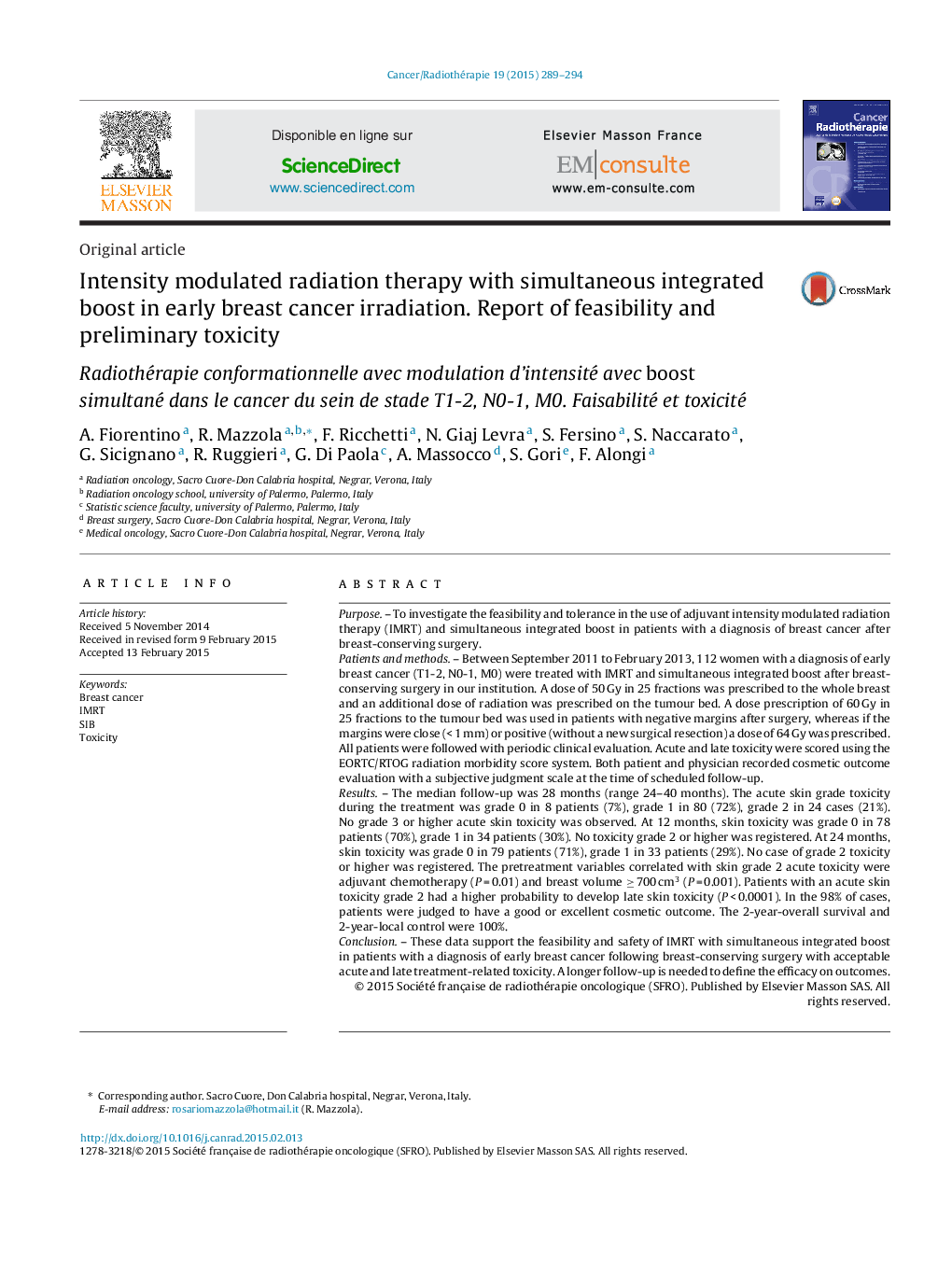| کد مقاله | کد نشریه | سال انتشار | مقاله انگلیسی | نسخه تمام متن |
|---|---|---|---|---|
| 2117273 | 1085198 | 2015 | 6 صفحه PDF | دانلود رایگان |
PurposeTo investigate the feasibility and tolerance in the use of adjuvant intensity modulated radiation therapy (IMRT) and simultaneous integrated boost in patients with a diagnosis of breast cancer after breast-conserving surgery.Patients and methodsBetween September 2011 to February 2013, 112 women with a diagnosis of early breast cancer (T1-2, N0-1, M0) were treated with IMRT and simultaneous integrated boost after breast-conserving surgery in our institution. A dose of 50 Gy in 25 fractions was prescribed to the whole breast and an additional dose of radiation was prescribed on the tumour bed. A dose prescription of 60 Gy in 25 fractions to the tumour bed was used in patients with negative margins after surgery, whereas if the margins were close (< 1 mm) or positive (without a new surgical resection) a dose of 64 Gy was prescribed. All patients were followed with periodic clinical evaluation. Acute and late toxicity were scored using the EORTC/RTOG radiation morbidity score system. Both patient and physician recorded cosmetic outcome evaluation with a subjective judgment scale at the time of scheduled follow-up.ResultsThe median follow-up was 28 months (range 24–40 months). The acute skin grade toxicity during the treatment was grade 0 in 8 patients (7%), grade 1 in 80 (72%), grade 2 in 24 cases (21%). No grade 3 or higher acute skin toxicity was observed. At 12 months, skin toxicity was grade 0 in 78 patients (70%), grade 1 in 34 patients (30%). No toxicity grade 2 or higher was registered. At 24 months, skin toxicity was grade 0 in 79 patients (71%), grade 1 in 33 patients (29%). No case of grade 2 toxicity or higher was registered. The pretreatment variables correlated with skin grade 2 acute toxicity were adjuvant chemotherapy (P = 0.01) and breast volume ≥ 700 cm3 (P = 0.001). Patients with an acute skin toxicity grade 2 had a higher probability to develop late skin toxicity (P < 0.0001). In the 98% of cases, patients were judged to have a good or excellent cosmetic outcome. The 2-year-overall survival and 2-year-local control were 100%.ConclusionThese data support the feasibility and safety of IMRT with simultaneous integrated boost in patients with a diagnosis of early breast cancer following breast-conserving surgery with acceptable acute and late treatment-related toxicity. A longer follow-up is needed to define the efficacy on outcomes.
RésuméObjectif de l’étudeÉtudier la faisabilité et la tolérance d’une radiothérapie conformationnelle avec modulation d’intensité (RCMI) et boost simultané pour des cancers du sein après chirurgie conservatrice.Patientes et méthodesEntre septembre 2011 et février 2013, 112 patientes atteintes d’un cancer du sein de stade T1-2, N0-1, M0 ont reçu une RCMI avec boost simultané après chirurgie conservatrice. Une dose de 50 Gy en 25 fractions a été prescrite dans le volume cible prévisionnel mammaire, ainsi qu’un boost dans le lit tumoral, pour atteindre 60 Gy en 25 fractions en cas de marges d’exérèse saines et 64 Gy en cas de marges étroites (moins de 1 mm) ou d’atteinte des tranches de section. Les patientes ont été régulièrement suivies, et la toxicité aiguë et tardive évaluée selon la classification de l’European Organization for Research and Treatment of Cancer (EORTC) et du Radiation Therapy Oncology Group (RTOG). Le résultat esthétique a été évalué subjectivement à la fois par la patiente et le médecin à la fin du suivi.RésultatsLe suivi a été en médiane de 28 mois (24–40). La toxicité cutanée aiguë a été de grade 0 chez huit patientes (7 %), 1 chez 80 (72 %), 2 chez 24 (21 %) et 3 chez aucune. À 12 mois, la toxicité cutanée était de grade 0 chez 78 (70 %), 1 chez 34 (30 %), 2 ou plus chez aucune, à 24 mois 0 chez 79 (71 %), 1 chez 33 (29 %), 2 ou plus chez aucune. Il y avait une corrélation entre la toxicité cutanée de grade 2 et la chimiothérapie adjuvante (p = 0,01) et un volume mammaire 700 cm3 ou plus (p = 0,001). La toxicité tardive s’est avérée plus fréquente en cas de toxicité aiguë de grade 2 (p < 0,0001). Le résultat esthétique était bon ou excellent dans 98 % des cas. La probabilité de survie à 2 ans était de 100 %.ConclusionLa RCMI avec boost simultané s’est avérée faisable et sure après chirurgie conservatrice chez les patients atteintes d’un cancer du sein de stade T1-2, N0-1, M0. Un suivi plus long est requis pour tirer des conclusions définitives.
Journal: Cancer/Radiothérapie - Volume 19, Issue 5, August 2015, Pages 289–294
